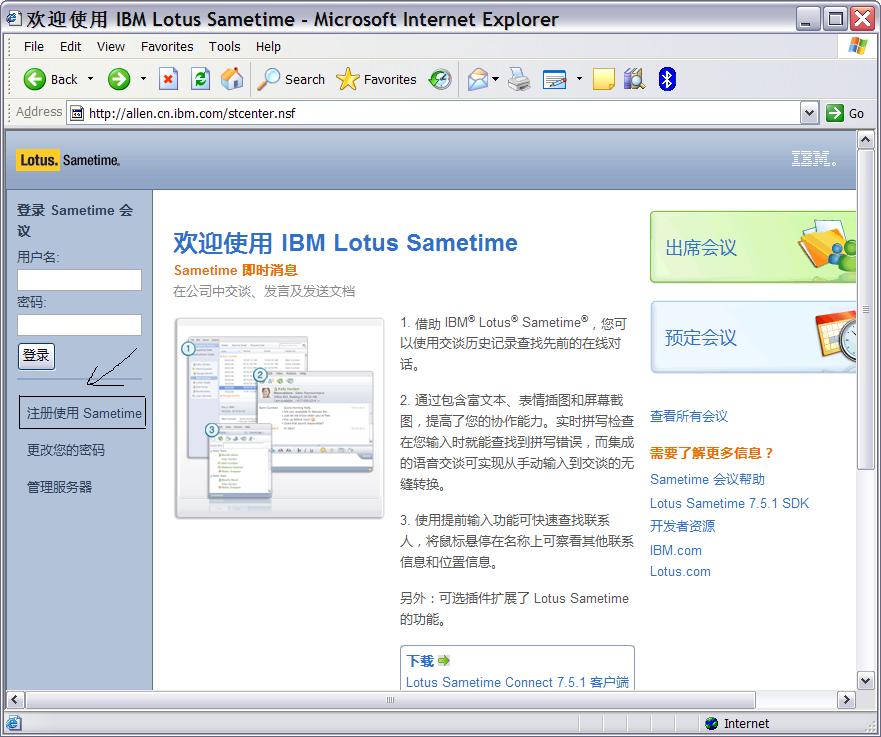2006年12月29日
一、軟件準(zhǔn)備:
IBM Lotus Domino Server 7.0.2 ;
IBM Lotus Notes Designer and Admin Client 7.0.2 ;
IBM Lotus Sametime Server 7.5.1 ;
IBM Lotus Sametime Connect 7.5.1 ;
二、安裝順序:
Domino Server->Sametime Server->Notes Admin Client->Sametime Client
三、Domino Server安裝:
1.按照提示安裝Domino Server,選擇Domino Enterprise Server
2.運(yùn)行Server Setup Program
3.選擇Set up the first server or a new Domino domain.
4.填寫Server name和Server title,Organization Name和Organization Certifier password
5.填寫管理員的名稱和密碼,一定要記錄該用戶名和密碼
6.選中Domino Server提供的Http Services
7.不必選中LDAP Service
四、Sametime Server安裝:
1.按照提示安裝Sametime Server,如果需要激活80端口,選中Enable HTTP tunneling。
2.啟動(dòng)Sametime歡迎界面,
http://domain/stcenter.nsf ,登錄至管理頁面,如果無法登錄,可能是域名解析問題,將域名與ip的對(duì)應(yīng)關(guān)系添加到windows/system32/drivers/etc/host文件中
3.如果歡迎界面沒有用戶注冊(cè)選項(xiàng),需管理員開啟該功能。
在管理頁面中選擇Domino目錄->Domino,勾選
允許用戶注冊(cè)到 Domino 目錄一項(xiàng),該項(xiàng)需重啟服務(wù)器,并在后面操作中給予權(quán)限支持。http://domain/stcenter.nsf 注冊(cè)用戶
向已有的TreeViewer和TableViewer上添加編輯功能,可以使用CellEditor和CellModifier。
CellEditor定義了某個(gè)列被編輯時(shí)顯示的外觀,它可以是文本框、下拉列表框或單選框,也可以自己定義。
通常使用的CellEditor的子類就是:CheckboxCellEditor、ComboBoxCellEditor和TextCellEditor。
????CellEditor[]?cellEditors?
=
?
new
?CellEditor[
5
];
0
]?
=
?
new
?TextCellEditor(tableViewer.getTable());
1
]?
=
?
null
;
2
]?
=
?
new
?ComboBoxCellEditor(tableViewer.getTable(),?
new
?String[]{
"
first
"
,?
"
second
"
,?
"
third
"
,?
"
forth
"
});
3
]?
=
?
new
?CheckboxCellEditor(tableViewer.getTable());
4
]?
=
?
new
?CustomizedTextCellEditor(tableViewer.getTable());
其中CustomizedTextCellEditor是自定義的CellEditor,避免了設(shè)置value時(shí)造成的空指針異常。
protected ? class ?CustomizedTextCellEditor? extends ?TextCellEditor { public ?CustomizedTextCellEditor(Composite?parent) { super (parent); protected ? void ?doSetValue(Object?value)? { if (value? == ? null ) return ; super .doSetValue(value); ????????
ICellModifier定義了三個(gè)接口方法:
public boolean canModify(Object element, String property);
public Object getValue(Object element, String property);
此處雖然可以返回Object類型的引用,但是使用時(shí)需小心,特定的CellEditor僅接受特定類型的Value。比如:
public void modify(Object element, String property, Object value);
import ?org.eclipse.debug.core.DebugException; import ?org.eclipse.debug.core.model.IVariable; import ?org.eclipse.debug.internal.ui.DebugUIPlugin; import ?org.eclipse.debug.internal.ui.DefaultLabelProvider; import ?org.eclipse.debug.internal.ui.VariableValueEditorManager; import ?org.eclipse.debug.ui.actions.IVariableValueEditor; import ?org.eclipse.jface.viewers.ICellModifier; /**?*/ /** @since ?3.2 */ public ? class ?DefaultVariableCellModifier? implements ?ICellModifier? { /**/ /* ?(non-Javadoc) */ public ? boolean ?canModify(Object?element,?String?property)? { if ?(VariableColumnPresentation.COLUMN_VARIABLE_VALUE.equals(property))? { if ?(element? instanceof ?IVariable)? { return ?((IVariable)?element).supportsValueModification(); return ? false ; /**/ /* ?(non-Javadoc) */ public ?Object?getValue(Object?element,?String?property)? { if ?(VariableColumnPresentation.COLUMN_VARIABLE_VALUE.equals(property))? { if ?(element? instanceof ?IVariable)? { = ?(IVariable)?element; try ? { return ?DefaultLabelProvider.escapeSpecialChars(variable.getValue().getValueString()); ? catch ?(DebugException?e)? { return ? null ; /**/ /* ?(non-Javadoc) */ public ? void ?modify(Object?element,?String?property,?Object?value)? { = ?getValue(element,?property); if ?( ! value.equals(oldValue))? { if ?(VariableColumnPresentation.COLUMN_VARIABLE_VALUE.equals(property))? { if ?(element? instanceof ?IVariable)? { = ?(IVariable)?element; = ?VariableValueEditorManager.getDefault().getVariableValueEditor(variable.getModelIdentifier()); if ?(value? instanceof ?String)? { = ?DefaultLabelProvider.encodeEsacpedChars((String)value); if ?(editor? != ? null )? { if ??(editor.saveVariable(variable,?(String)?value,?DebugUIPlugin.getShell()))? { return ; try ? { ? catch ?(DebugException?e)? {
GEF編輯器是構(gòu)架在Draw2D的FigureCanvas上的,而FigureCanvas是swt中Canvas的子類.
當(dāng)?shù)玫紽igureCanvas之后,就可以得到GEF編輯器的區(qū)域和GEF編輯器內(nèi)部畫布的大小:
編輯器區(qū)域大小:FigureCanvas.getBounds();
畫布大小:FigureCanvas.getContents.getBounds();
若要觸發(fā)GEF編輯器的滾動(dòng)條操作,僅需調(diào)用FigureCanvas的scrollToX(int hOffset)和scrollToY(int vOffset)即可.
獲取FigureCanvas的方法也比較簡(jiǎn)單.通過EditPart.getViewer()獲得EditPartViewer,一般情況下EditPartViewer的Control就是FigureCanvas.
列出代碼如下:
FigureCanvas?canvas?
=
?(FigureCanvas)EditPart.getViewer().getControl();
500
);
600
);
這個(gè)函數(shù)用法經(jīng)常忘..(String[])ArrayList.toArray(new String[0]);
摘要: 樹節(jié)點(diǎn)定義:class?TreeNode?{????public?TreeNode?left;????public?TreeNode?right;????public?int?value;????public?TreeNode(TreeNode?left,?TreeNode?right,?int?value)?{????????this.left?=?left;????????this.right...
閱讀全文
轉(zhuǎn)換成相對(duì)坐標(biāo), 要運(yùn)用translateToRelative(Point point)方法.
例如,在Eclipse Editor視圖中加入Figure,需要計(jì)算出相對(duì)于HostFigure的坐標(biāo),才能正確將figure放在鼠標(biāo)點(diǎn)擊的位置.可以如下這樣做:
在getCreateCommand(CreateRequest request)方法中,加入如下語句:
Point location = request.getLocation().getCopy();
能夠獲得當(dāng)前光標(biāo)絕對(duì)坐標(biāo) 的方法是:
最近項(xiàng)目中出現(xiàn)了一個(gè)bug,提示是Resource can not sync with file system.是文件系統(tǒng)不同步的問題,需要手動(dòng)刷新一下資源管理器.
刷新資源管理器調(diào)用方法:
RefreshLocal
public void refreshLocal(int depth, IProgressMonitor monitor)
Refreshes the resource hierarchy from this resource and its children (to the specified depth) relative to the local file system. Creations, deletions, and changes detected in the local file system will be reflected in the workspace's resource tree. This resource need not exist or be local.
If a new file or directory is discovered in the local file system at or below the location of this resource, any parent folders required to contain the new resource in the workspace will also be created automatically as required.
This method is long-running; progress and cancellation are provided by the given progress monitor.
該方法位于org.eclipse.core.resources.IResource
我的調(diào)用方法是:
ResourcesPlugin.getWorkspace().getRoot().refreshLocal(IResource.DEPTH_INFINITE, monitor);
摘要: 類似于Java Swing 中的JDateChooser,SWT里有沒有相類似的日期選擇控件呢?
目前有幾種方式提供SWT的時(shí)間控件:
1.eclipse 3.3自帶的org.eclipse.swt.widgets.DateTime控件.?? eclipse 3.3版本增加了對(duì)日期選擇控件的支持,下面是官方提供的示例代碼:
import
?o...
閱讀全文
如同編程人員找到了優(yōu)秀的IDE一樣,我找到了我想要的Blog.






 ????
???? ????????
???????? ????}
????} }
}


